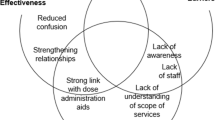Abstract
Background: This article presents the results of a study on quality of pharmacy services and perceived risk of pharmaceuticals. The results presented here are part of a multi-study evaluation of major changes in drug distribution in Iceland. Objectives: This sub-study addressed the question: what is the lay user perspective on pharmaceuticals and pharmacy services, including their perception of risk? Methods: To answer this question, seven focus group discussions were conducted with pharmacy customers in different locations in Iceland following new drug distribution legislation in 1996.Results: The lay perspective emphasizes a definite split between lay and expert views on the value and quality of pharmaceuticals, drug therapy and pharmacy services, as well as in their assessment of risk. Participants voiced spontaneous criticism of the roles of both physicians and pharmacists in drug therapy; and expressed concern about the quality and safety of pharmaceuticals. Some scope for shared values was noted between the legislative goals and the lay user perspective, despite the fact that the public was in no way involved in the drafting of the new legislation. Conclusion: The results of this study raise questions about the nature and extent of the perceived gap between the medical and pharmacy professions on the one side and the lay public and health policy decision-makers on the other side in their views on the quality and safety of pharmaceuticals and pharmacy services.
Similar content being viewed by others
References
Nettleton S. The sociology of health and illness. Cambridge: Polity Press, 1995.
Calnan M. Health and illness: the lay perspective. London: Tavistock, 1987.
Williams G, Popay J. Lay knowledge and the privilege of experience. In: Gabe J, Kelleher D, Williams G, editors. Challenging medicine. London: Routledge, 1994.
Abraham J, Sheppard J. Democracy, technocracy, and the secret state of medicines control: expert and nonexpert perspectives. Sci Technol Hum Val 1997;22(2):139–67.
Royal Pharmaceutical Society of Great Britain. Why professionals and patients need to talk. Connect 1998;1(winter).
Britten N. Lay views of drugs and medicines: orthodox and unorthodox accounts. In: Williams S, Calnan M, editors. Modern medicine-lay perspectives and experiences. London: UCL Press, 1996:48–73.
Brown J. Environmental threats: perception analysis and management. London: Bellhaven Press, 1989.
Björnsdóttir I, Hansen EH. Telephone prescribing of antibiotics: general practitioners' views and reflections. Eur J Public Health 2001;11:260–3.
Hansen EH. Rationality and common sense in Danish drug therapy. J Soc Adm Pharm 1988;5:105–13.
Hansen EH, Launsø L, Morgall J. Forsøg, læring, evaluering. Samarbejde mellem brugerorganisationer & apoteksfarmaceuter om lægemiddelanvendelse. [Experimenting, learning, evaluating. Cooperation between patient organizations and community pharmacists regarding drug utilization.] Copenhagen: The Royal Danish School of Pharmacy, 1989.
Beck U. Risk society-towards a new modernity. London: Sage Publications, 1992.
Almarsdóttir AB, Morgall JM, Björnsdóttir I. A question of emphasis: efficiency or equality in the provision of pharmaceuticals. Int J Health Plann Manage 2000;15:149–61.
Gunnlaugsson GÁ. Population and migration patterns 1880–1990. In: Hálfdanarson G, Kristjánsson S, editors. Icelandic societal development 1880–1990: essays. Reykjavik: University of Iceland Social Science Research Institute; 1993:109 [in Icelandic].
Fontana A, Frey JH. Interviewing: the art of science. In: Denzin NK, Lincoln YS, editors. Handbook of qualitative research. London: Sage, 1994.
Gabe J. Medicine, health and risk-sociological approaches. Oxford: Blackwell Publishers, 1995.
Hassell K, Noyce P, Rogers A, Harris J, Wilkinson J. Advice provided in British community pharmacies-what people want and what they get. J Health Serv Res Policy 1998;3(4): 219–25.
Hibbert D, Bissel P, Ward P. Consumerism and professional work in community pharmacy. Sociol Health Ill 2002:46–65.
Britten N. Patients' ideas about medicines: a qualitative study in a general practice population. Br J Gen Pract 1994;44(387):465–8.
Horne R, Weinman J, Hankins M. The Beliefs about Medicines Questionnaire (BMQ): a new method for assessing cognitive representations of medication. Psychol Health 1999;10:1–29.
Morgall JM, Almarsdóttir AB. No struggle, no strength-how pharmacists lost their monopoly. Soc Sci Med 1999;48(9):71–82.
Author information
Authors and Affiliations
Corresponding author
Rights and permissions
About this article
Cite this article
Morgall Traulsen, J., lmarsdóttir, A.B. & Björnsdóttir, I. The lay user perspective on the quality of pharmaceuticals, drug therapy and pharmacy services – results of focus group discussions. Pharm World Sci 24, 196–200 (2002). https://doi.org/10.1023/A:1020505014006
Issue Date:
DOI: https://doi.org/10.1023/A:1020505014006



